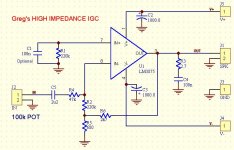IGC with High input impedance!
For the ones that need higher input impedance and like the Inverted topology that’s what I came up with. It’s a popular way to control the gain of an opamp, but I haven’t seen it applied in the IGC.
The shown sch has input impedance of 47k but you can go to 100k if you need to by changing R4. You’d need to change the two 220k res to 470k so that the gain stays the same. The AC gain is ~ (R2/R4)*(R6/R5). So you can play with the values, though try to keep R6/R5 as low as possible because the same two resistors determine the DC gain of the amp. The lower the DC gain, the lower the Output offset. Also to keep the offset low (single digit mV’s) keep R1 and R2 the same value (1% tolerance if possible). On the other hand R1 and R2 shouldn’t be more than 470k (noise susceptibility).
/Greg
For the ones that need higher input impedance and like the Inverted topology that’s what I came up with. It’s a popular way to control the gain of an opamp, but I haven’t seen it applied in the IGC.
The shown sch has input impedance of 47k but you can go to 100k if you need to by changing R4. You’d need to change the two 220k res to 470k so that the gain stays the same. The AC gain is ~ (R2/R4)*(R6/R5). So you can play with the values, though try to keep R6/R5 as low as possible because the same two resistors determine the DC gain of the amp. The lower the DC gain, the lower the Output offset. Also to keep the offset low (single digit mV’s) keep R1 and R2 the same value (1% tolerance if possible). On the other hand R1 and R2 shouldn’t be more than 470k (noise susceptibility).
/Greg
